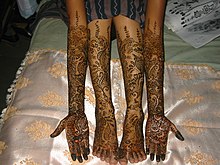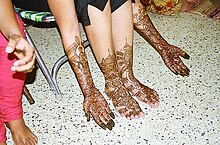What Is It Called When Hindu Women Draw Art on Their Body

Mehndi applied on both hands; back view.

Mehndi applied on the back of both hands.
Video of mehendi application.
Mehndi is a course of body art and temporary skin ornament from the Indian subcontinent usually drawn on hands or legs, in which decorative designs are created on a person's body, using a paste, created from the powdered dry leaves of the henna found (Lawsonia inermis). It is a popular form of torso art among the women of Southward Asia such as India, Bangladesh, Pakistan, Maldives, Sri Lanka, Nepal and resembles Similar practices found in North Africa, Eastward Africa and the Center E, see Henna#Traditions of henna as body fine art. In the W, mehndi is known as "henna tattoo".
Henna was first applied equally a means to cool down the body. A dot was applied to the palm of the easily and helped to cool the body. Later on condign bored with the wait of the unmarried dot on the palm, the early on users of henna began to add lines and other shapes. Eventually this elaboration became the beautiful designs we see today.
Henna has been used equally a dye for the pare since ancient times.
It was originally used for only women'southward palms and sometimes for men, merely as time progressed, it was more common for women to wear it[ citation needed ].
There are many variations and designs. Women usually apply mehndi designs to their hands and feet, though some, including cancer patients and women with alopecia occasionally decorate their scalps.[one] The standard color of henna is brown, but other design colors such as white, cherry, black and golden are sometimes used.[1]
In Hindu festivals, women often have henna applied to their hands, feet and sometimes the backs of their shoulders. Conversely, men usually take information technology applied on their arms, legs, back, and breast. For women, it is usually drawn on their palms, backs of their hands and on feet, where the design will exist clearest due to dissimilarity with the lighter skin on these surfaces, which naturally contains less of the paint melanin.
Alta, Alata, or Mahur is a red dye used similarly to henna to paint the feet of the brides in some regions of the Indian subcontinent.
Likely due to the desire for a "tattoo-black" advent, some people add the synthetic dye p-Phenylenediamine (PPD) to henna to requite it a blackness color. PPD may cause moderate to severe allergic reactions when applied to skin. [2]
Etymology [edit]
The origin of "mehndi" is from the Sanskrit word "mendhika,"[3] which refers to a constitute that releases a ruddy dye.[four] [5] According to A Lexicon of Urdu, Classical Hindi and English language Mehndi besides refers to "the union-banquet on the occasion of the bride's hands and feet existence stained with henna."[six]
Origins [edit]
The employ of mehndi has its origins in the ancient Middle East and Indian Subcontinent where it was used in civilizations such equally Babylon and Aboriginal Egypt. Information technology was prevalent in fourth century in India, which is evident from cave fine art in the Deccan, specifically in the Ajanta Caves.[7]
Tradition [edit]

Mehendi decoration of palms and anxiety

Mehendi ornamentation of palms and feet of a bride
Mehndi is a formalism art form mutual in Bharat, Pakistan, People's republic of bangladesh, and occasionally Afghanistan. Mehndi in Indian tradition is typically applied during Hindu weddings and festivals like Karva Chauth, Vat Purnima, Diwali, Bhai Dooj, Navraathri, Durga Pooja, and Teej. Muslims in Southern asia too apply mehndi during Muslim weddings, and festivals such as Eid-ul-Fitr and Eid-ul-Adha.
Process [edit]
Mehndi paste is usually applied to the skin using a plastic cone, a paintbrush or a stick. After about 15–xx minutes, the mud will dry and begin to crack, and during this time, a mixture of lemon juice and white sugar can be applied over the henna design to remoisten the henna mud and so that the henna will stain darker. The painted expanse is and so wrapped with tissue, plastic, or medical tape to lock in trunk estrus, creating a more intense colour on the skin. The wrap (not a traditional method), is worn for two to half dozen hours, or sometimes overnight, and then removed. When first removed, the henna design is pale to dark orangish in colour and gradually darkens through oxidation, over the course of 24 to 72 hours. The concluding color is reddish brown and can last anywhere from i to 3 weeks depending on the quality and type of henna paste practical, besides equally where information technology was applied on the body (thicker skin stains darker and longer than thin pare). Moisturizing with natural oils, such every bit olive, sesame seed, or coconut, volition as well help extend the lifetime of the stain. Pare exfoliation causes the henna tattoo to fade.[ citation needed ]
In weddings [edit]
Case of a hymeneals tradition [edit]
The Mehndi, a dye produced from a mehndi plant, would exist delivered past the groom'due south relatives on a silver tray containing two burning candles.[viii] [ix] Before the application of the henna, the guests would throw coins over the helpmate'south caput as a symbol of fertility. Then, the bride'south presently to be mother-in-law would then bring out a piece of silk cloth as a gift to the bride. The helpmate would then walk along the unrolled piece of silk cloth in the direction of her future mother in law and kiss her hand.
Once this is done, fruits, nuts, and pastries would be brought out and songs would be sung in hopes of making the bride weep. This was washed because it was idea that the bride's crying would bring skilful luck. The bride would then sit down on a cushion while her mother in law placed a gold coin in her hand every bit another sign of proficient luck. One time the helpmate was given the gold coin, the henna would be applied.
The person who applied the henna was always someone who was already known to exist happily married; that person would apply the henna onto the bride'south palms, fingers, and toes. The henna was made from dried henna leaves, and the process of awarding took a long fourth dimension. For this reason, it was suggested that it be applied between xxx-two and xl-eight hours earlier the hymeneals then that information technology may have plenty fourth dimension to stain the skin. In addition to the bride, most women at the mehndi ceremony likewise apply the henna to their hands for aesthetics.
Popular Mehndi Patterns [edit]
Arabic Mehndi Designs [edit]
This design is fatigued on the palm. Generally information technology starts from one corner of the wrist and ends at finger tip on the contrary corner. Vine, lace, flowers are the main elements of this design.
Mandala Mehndi Designs [edit]
Mandala is a geometric configuration of symbols used in diverse spiritual traditions including Hinduism, Buddhism, Jainism and Shintoism. Various configurations of Mandala are drawn on the center of palm in this mehndi pattern.
Encounter also [edit]
- Henna
- Alta
- Trunk painting
- Temporary tattoo
References [edit]
| | Wikimedia Eatables has media related to Mehndi. |
- ^ a b "The next big thing on Eid is white mehndi, and I tried it - Style - Images". Images.dawn.com. 24 June 2017. Retrieved 2019-04-30 .
- ^ Mukkanna, Krishna Sumanth; Rock, Natalie M; Ingram, John R (2017-01-18). "Para-phenylenediamine allergy: current perspectives on diagnosis and management". Periodical of Asthma and Allergy. 10: nine–xv. doi:10.2147/JAA.S90265. ISSN 1178-6965. PMC5261844. PMID 28176912.
- ^ Stevenson, Angus; Waite, Maurice (2011-08-xviii). Concise Oxford English Dictionary: Luxury Edition. OUP Oxford. p. 890. ISBN978-0-19-960111-0.
- ^ "A dictionary of Urdu, classical Hindi, and English language". archive.ph. 2012-07-09. Retrieved 2022-04-27 .
- ^ world wide web.wisdomlib.org (2019-01-02). "Mendhika, Mendhikā: 6 definitions". www.wisdomlib.org . Retrieved 2022-04-27 .
- ^ A lexicon of Urdu, classical Hindi, and English. Dsal.uchicago.edu. Retrieved on 2011-09-26.
- ^ International, Aroha (2017-x-01). "History, Origin & Cultural Significance of Henna". Aroha International . Retrieved 2021-05-27 .
- ^ "The Beautiful and Intricate Application of Bridal Henna". The Bandbox . Retrieved 19 August 2018.
- ^ "Henna Party". www.turkishculture.org . Retrieved xix August 2018.
Source: https://en.wikipedia.org/wiki/Mehndi#:~:text=Mehndi%20is%20a%20form%20of,henna%20plant%20(Lawsonia%20inermis).
0 Response to "What Is It Called When Hindu Women Draw Art on Their Body"
Postar um comentário